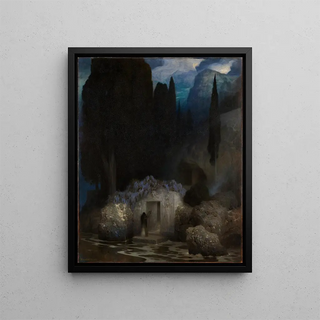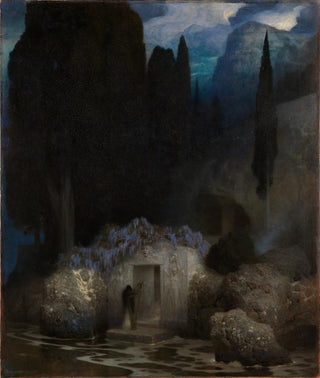Painting Böcklins Grave - Ferdinand Keller | Art print Source: Tableau Böcklins Grab - Ferdinand Keller | Reproduction


View from behind

Frame (optional)
In the fascinating world of art, certain works transcend the mere frame to become windows into deep emotions and reflections on the human condition. "Böcklins Grab" by Ferdinand Keller is one of these works. It evokes not only the beauty of the landscape but also melancholy and contemplation of death, a theme dear to many 19th-century artists. Through this piece, Keller invites us to dive into a world where nature and spirit meet, where the living and the dead coexist in a haunting harmony. This art print perfectly illustrates the essence of the original work, allowing the viewer to appreciate the depth of feelings and the richness of details that characterize this creation.
Style and uniqueness of the work
Ferdinand Keller's style is distinguished by its romantic approach, rooted in the tradition of landscape painting while incorporating symbolic elements. "Böcklins Grab" is presented as an ode to nature, where each element is carefully arranged to create an atmosphere that is both serene and filled with mystery. The colors, subtly nuanced, evoke the variations of light through the foliage, while the organic shapes of trees and rocks seem to dialogue with the shadow of the tomb. This work does not merely depict a place; it evokes an experience, a sensation of loss and memory. The composition, both balanced and dynamic, guides the viewer's gaze across the painting, encouraging a contemplative exploration of the universal themes of life and death.
The artist and his influence
Ferdinand Keller, often less known than his contemporaries, managed to establish himself as a significant figure in the German romantic landscape. His work reflects an era when art was not limited to simple representation but became a means of exploring existential questions. Influenced by artists such as Arnold Böcklin, Keller was able to incorporate symbolist elements into his compositions, thus creating a rich and evocative visual language. His work was also marked by particular attention to detail, both in the depiction of landscapes and human emotions. In rediscovering "Böcklins Grab," one

Matte finish

View from behind

Frame (optional)
In the fascinating world of art, certain works transcend the mere frame to become windows into deep emotions and reflections on the human condition. "Böcklins Grab" by Ferdinand Keller is one of these works. It evokes not only the beauty of the landscape but also melancholy and contemplation of death, a theme dear to many 19th-century artists. Through this piece, Keller invites us to dive into a world where nature and spirit meet, where the living and the dead coexist in a haunting harmony. This art print perfectly illustrates the essence of the original work, allowing the viewer to appreciate the depth of feelings and the richness of details that characterize this creation.
Style and uniqueness of the work
Ferdinand Keller's style is distinguished by its romantic approach, rooted in the tradition of landscape painting while incorporating symbolic elements. "Böcklins Grab" is presented as an ode to nature, where each element is carefully arranged to create an atmosphere that is both serene and filled with mystery. The colors, subtly nuanced, evoke the variations of light through the foliage, while the organic shapes of trees and rocks seem to dialogue with the shadow of the tomb. This work does not merely depict a place; it evokes an experience, a sensation of loss and memory. The composition, both balanced and dynamic, guides the viewer's gaze across the painting, encouraging a contemplative exploration of the universal themes of life and death.
The artist and his influence
Ferdinand Keller, often less known than his contemporaries, managed to establish himself as a significant figure in the German romantic landscape. His work reflects an era when art was not limited to simple representation but became a means of exploring existential questions. Influenced by artists such as Arnold Böcklin, Keller was able to incorporate symbolist elements into his compositions, thus creating a rich and evocative visual language. His work was also marked by particular attention to detail, both in the depiction of landscapes and human emotions. In rediscovering "Böcklins Grab," one
12,34 €






